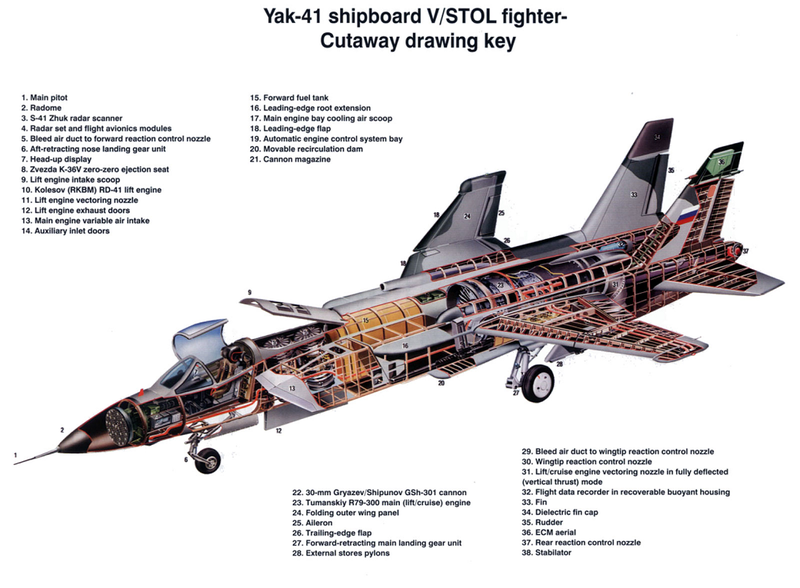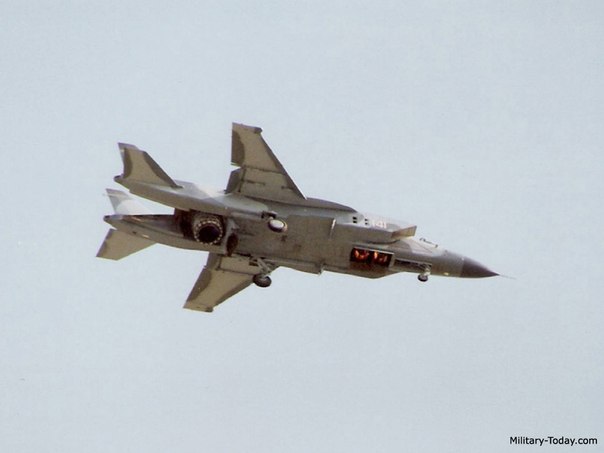Yak 141 (russian mother of f-35)



Yakovlev always believed the Yak-38 to be an interim aircraft, developed to gain experience designing and developing military VTOL aircraft. Even before the Yak-38's introduction, the Soviet Navy desired a more comprehensive aircraft, with greater capabilities than the Yak-38 offered. The result was a design contract offered to Yakovlev in 1975 without any competition. The requirement was for an aircraft with only one mission: air defense of the fleet. Unlike the Yak-38, this aircraft was to have sustained supersonic speed. Maneuverability, radar and weapons loads were expected to be similar to those of current front-line fighters. For the Soviet Navy this aircraft was to be their next generation VTOL fighter. For Yakovlev the aircraft was viewed as a way of returning to designing Soviet fighter aircraft.
Because of the importance and complexity of the project, Alexander Sergeyevich Yakovlev assigned a large portion of his OKB to the development of the new VTOL fighter, with no fewer than ten chief engineers working simultaneously on what was called "Product 48" (the military had designated it Yak-41). Over fifty designs were studied. One key problem was designing an aircraft with both vectoring thrust and an afterburner, which was essential for sustained supersonic speeds. A twin-engine design was considered, but abandoned as the loss of an engine on landing would result in an immediate roll to the side. Eventually it was decided that the best arrangement was a single vectoring nozzle located just behind the center of gravity, as well as dedicated vertical thrust jets positioned just behind the cockpit. A considerable amount of time was spent in the development of a flat, rectangular nozzle similar to that later employed on the American F-22 Raptor. Such a nozzle proved well-suited for the changes in configuration needed for both thrust vectoring and supersonic flight, and allowed for a thin, shallow tail. Ultimately, a circular nozzle was used, located between twin booms supporting the twin-finned tail.
Parts that were to be subjected to excessive heat from the engines during landing were manufactured of titanium, and no less than 26% of the overall aircraft was to be manufactured of graphite or composite material. Because of heat build-up, hovering was restricted to no more than 2½ minutes.
All three engines were controlled through an interlinked digital system, which was capable of controlling both engine start-up as well as modulating the thrust of all three engines during landing and hovering flight. Twin tandem reaction control jets were positioned at the wingtips, while a swiveling yaw jet was positioned under the nose.
The cockpit was pressurized and air-conditioned. The small canopy was bulletproof in front. It hinged to the right, but because of a long dorsal spine it had no rear vision. The ejection seat was automatically armed as soon as the engine duct was rotated past 30 degrees with an airspeed of less than 300 km/h (186 mph). The instrumentation in the prototypes was simple and similar to that planned for the earlier Yak-36M. The production version was to have been fitted with an extensive avionics and weapons suite including doppler radar, laser-TV ranging and aiming, as well as a heads-up multifunction display (HUD) which worked in connection with a helmet-mounted missile aiming system as found on the Mikoyan MiG-29. This system allows the pilot to lock onto an enemy aircraft by turning his head as far as 80 degrees from front.
The undercarriage was tricycle, and equipped with the latest multi-disc, anti-skid brakes. The steerable nose wheel retracted to the rear, while the main gear retracted forward.
The top-mounted wing was similar to that of the Yakovlev Yak-36, though the outer panel swept back, and could be folded up for shipboard storage. The main engine was served by four side-mounted ducts as well as a row of large louvers along the upper surface to allow air to enter the engine during full power hovering. This engine was the R-79V-300, a two-shaft augmented turbofan with a bypass ratio of 1. Maximum thrust was 14,000 kg (30,864 lb). The rear nozzle could rotate from 0 degrees to 95 degrees for VTOL landing and hovering. The two lift engines were the RD-41 design, a simple single-shaft engine made mostly of titanium. Each had a thrust of 4,100 kg (9,040 lb). The engines were installed behind the cockpit at an angle of 85 degrees. Like the Yak-38, the engines received their air through eight spring-operated dorsal flaps, and the exhaust exited through a belly opening covered by two ventral doors.
Lockheed Martin
Following the announcement by the CIS that it could no longer fund development of the Yak-41M, Yakovlev immediately entered into discussions with several foreign partners who could help fund the program (a tactic they were also pursuing for development of the Yak-130 trainer, which was eventually developed in partnership with Aermacchi of Italy). Lockheed Martin, which was in the process of developing the X-35 for the US Joint Strike Fighter program, quickly stepped forward, and with their assistance 48-2 was displayed at the Farnborough Airshow in September 1992. Yakovlev announced that they had reached an agreement with Lockheed-Martin for funds of $385 to $400 million for three new prototypes and an additional static test aircraft to test improvements in design and avionics. Planned modifications for the proposed Yak-41M included an increase in STOL weight to 21,500 kg (47,400 lb). One of the prototypes would have been a dual-control trainer. Though no longer flyable, both 48-2 and 48-3 were exhibited at the 1993 Moscow airshow. The partnership began in late 1991, though it was not publicly revealed by Yakovlev until 6 September 1992, and was not revealed by Lockheed-Martin until June 1994.
General characteristics
- Crew: 1
- Length: 18.36 m (60 ft 2¼ in)
- Wingspan: 10.105 m (33 ft 1½ in)
- Height: 5.00 m (16 ft 5 in)
- Wing area: 31.7 m² (341 ft²)
- Empty weight: 11,650 kg (25,683 lb)
- Max. takeoff weight: 19,500 kg (42,989 lb)
- Powerplant: 1 × MNPK Soyuz R-79V-300 lift/cruise turbofan
- Dry thrust: 108 kN (24,300 lbf)
- Thrust with afterburner: 152 kN (34,170 lbf)
- Lift engines: 2x RKBM RD-41 turbojets 41.7 kN (9,300 lbf) thrust each)
Performance
- Maximum speed: 1,800 km/h (1,118 mph, Mach 1.4+)
- Range: 2,100 km (1,305 mi)
- Ferry range: 3,000 km (1,865 mi)
- Service ceiling: 15,500 m (50,853 ft)
- Rate of climb: 15,000 m/min (49,213 ft/min)


Comments
Post a Comment